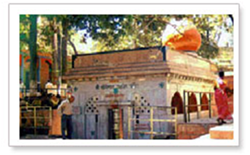 |
Rich Historical town of Legendary Lord Rama, who spent some time of his exile in Nashik is a unique blend of civilization& modernization. This City of temples is one of the holiest places for Hindus inviting thousands of tourist every year. Scenic beauty of Sahyadri range of mountains merged with vineyards & agricultural yields (Highest in India) and a busy hub of industrial activities. With the onset of monsoons and the start of Kumbhmela, Nashik is a paradise for tourists with Historical Caves,Temples, holy rituals, museums,etc. |
|
| 1. Trimbakeshwar Temple |
|
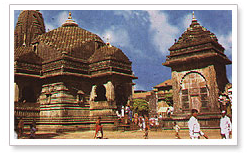 |
The village of Trimbak, 36 kms from Nashik, is famous for the Trimbakeshwar Temple and as the source of the Godavari River. Trimbakeshwar enshrines one of the 12 jyotirlingas dedicated to Shiva and this one is considered to be the main jyotirlinga.
Legend has it that Guatam Rishi performed a rigorous ritual of prayer and penance or tapasya to Shiva on Brahmagiri Hill which rise above the present-day temple. Pleased with this devotion, Shiva is said to have blessed him and brought down to earth from heaven the sacred rivers of Ganga, Gautami and Godavari. This temple was built by late Mr. Odhekar, a knight serving with Peshwas. There are great processions |
|
and utsav on Ramnavami, Dasara and Chaitra Padwa (Hindu new year day). The specialty of the temple is that it was built with black stones.It is said that anybody who visits Tryambakeshwar attains salvation. There is no sacred place like Tryambakeshwar, no river like Godavari, no mountain like Brahmagiri etc. The reasons for its being so sacred are - Godavari river originates in this place, its a place of Tri-Sandhya Gayatri, the birth place of Lord Ganesha, a place of the first Nath of Nath Sampradaya consisting of Gorakhnath and others, a place where Nivrittinath was made to imbibe the holy knowledge by his Guru Gahininath, a place where Nivrittinath made his brothers and sister attain the self by his preaching. This is the holiest place to perform Shraddha ceremony.
|
| 2. Ramkund |
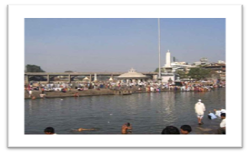 |
The village of Trimbak, 36 kms from Nashik, is famous for the Trimbakeshwar Temple and as the source of the Godavari River. Trimbakeshwar enshrines one of the 12 jyotirlingas dedicated to Shiva and this one is considered to be the main jyotirlinga.
Legend has it that Guatam Rishi performed a rigorous ritual of prayer and penance or tapasya to Shiva on Brahmagiri Hill which rise above the present-day temple. Pleased with this devotion, Shiva is said to have blessed him and brought down to earth from heaven the sacred rivers of Ganga, Gautami and Godavari. This temple was built by late Mr. Odhekar, a knight serving with Peshwas. There are great processions |
|
and utsav on Ramnavami, Dasara and Chaitra Padwa (Hindu new year day). The specialty of the temple is that it was built with black stones. It is said that anybody who visits Tryambakeshwar attains salvation. There is no sacred place like Tryambakeshwar, no river like Godavari, no mountain like Brahmagiri etc. The reasons for its being so sacred are - Godavari river originates in this place, its a place of Tri-Sandhya Gayatri, the birth place of Lord Ganesha, a place of the first Nath of Nath Sampradaya consisting of Gorakhnath and others, a place where Nivrittinath was made to imbibe the holy knowledge by his Guru Gahininath, a place where Nivrittinath made his brothers and sister attain the self by his preaching. This is the holiest place to perform Shraddha ceremony.
|
| 3. Godavari Ghat |
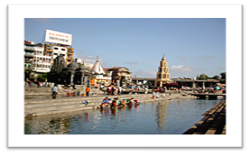 |
River Godavari flows through Nashik and its Northern part is known as Panchavati. Lord Shri Ram and Sita along with Laxman stayed at Panchavati during exile. There are five Banyan (Vad) trees and thua the reason it is called Panchavati.Nearby is Sita Gumpha (cave) where Sita stayed for some time. |
| 4. Sita Gumpha (Cave) |
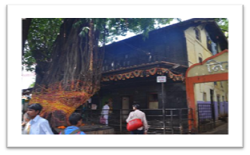 |
Sita Gumpha is at a distance of 2 km from Central Bus Stand. It is situated at the western side door of Kalaram Temple.Lord Rama's wife, Sita dwelled at this place and King Ravan abducted her from this place. The Shiv linga that she worshiped is still there in the gumpha.There are five Banyan trees in this area and thus called "Panchvati". |
| 5. Pandav Caves(Pandav Lani) |
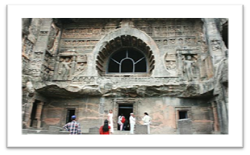 |
Pandav Lani is situated at a distance of 9km from Central Bus Stand. These are three mountain peaks of Anjinagiri mountain ranges. These caves were built by Jain Kings and are 2000 years old. The engravings inside the gumpha are believed to be of Pandavas of 17th Century and thus these caves are named as "Pandav Caves".
These historical caves created B.C.100 to 110 are loca ted on a tableland on the Trivashmi Hill. Together, there are 29 caves & may be training center for Buddha worshippers. Icons of Bhagwan Gautam Buddha & Bodhisatva are wonderful crafted . During Jain regime B.C. |
|
1000 to 1100 these were home to Jain saints. Inside the caves one can see idols of Buddha, Bodhisatva, Jain Tirthankar Vrishabhdeo, Veer Kapibhadra and Ambikadevi. The cave complex contains large caves which were the meeting places of the disciples, where sermons were preached. The caves were well designed with several water tanks chiseled into the rock. |
| 6. Artillery Centre |
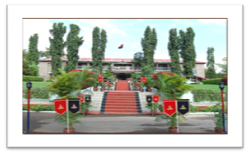 |
Behind the Pandav Caves, is the biggest Artillery Center in Asia. This artillery center was shifted from Pakistan in 1947, and is now completing its 50th year. The Indian army's officers and soldiers are trained here. Training for 'Bofors Gun' is given here. The area is under military and is restricted for civilians. |
| 7. Nandur Madhmeshwar |
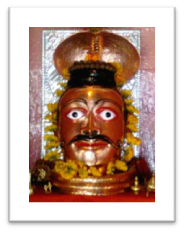 |
Through ceaseless efforts of Bombay Natural History Society, World Wildlife Fund and Forest Department of the Government of Maharashtra, this sanctuary which houses more than 220 species of birds, 400 species of vegetation, 24 species of fish and several smaller mammals came into existence along the Nandur Madhameshwar dam at the confluence of Godavari and Kadwa. Spread over the protected area of 10000 hectares, lies the core area of 1765 hectares, where the large variety of water birds,resident and migratory birds congregate in season. It is now counted as one of the important water fowl habitats in the region by the International Union of Conservation of Nature. Aptly called Maharashtra's Bharatpur developed since 1950 is favorite birdwatchers wetland area surrounded by fields of sugarcane, grape orchards. Large lake & islands abound with aquatic vegetation making it paradise for thousands of migratory birds, Ibises, Storks & variety of colorful water birds. The Madhmeshwar Temple on the river features prominently in Hindu mythology. Lord Ram is said to have killed the golden deer or Suvarnamrug at the spot where the temple stands today. The area around the lake is rich with fossils & visitors can find interesting pieces of these fascinating rocks scattered about. |
| 8. Naroshankar Temple |
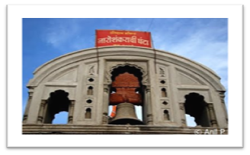 |
Situated in Panchavati area on the bank of river Godavari - fondly called as ganga by Nasikites - is Naroshankar Temple of Rameshwar built by Naroshankar Rajebahaddur in 1747. The architectural style of the temple is called "Maya". It is one of the most beautiful pieces of architecture of the 18th century. Sculpture on the outer side of the temple is which rise above the present-day temple. Pleased with this devotion, Shiva is said to have blessed him and brought down to earth from heaven the sacred rivers of Ganga, Gautami and Godavari. This temple was built by late Mr. Odhekar, a knight serving with Peshwas. There are great processions and utsav |
|
on Ramnavami, Dasara and Chaitra Padwa (Hindu new year day). The specialty of the temple is that it was built with black stones. It is said that anybody who visits Tryambakeshwar attains salvation. There is no sacred place like Tryambakeshwar, no river like Godavari, no mountain like Brahmagiri etc. The reasons for its being so sacred are - Godavari river originates in this place, its a place of Tri-Sandhya Gayatri, the birth place of Lord Ganesha, a place of the first Nath of Nath Sampradaya consisting of Gorakhnath and others, a place where Nivrittinath was made to imbibe the holy knowledge by his Guru Gahininath, a place where Nivrittinath made his brothers and sister attain the self by his preaching. This is the holiest place to perform Shraddha ceremony.
|
| 9. Veer Savarkar Smarak - Bhagur |
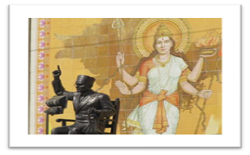 |
Bhagur is the birth place of the freedom fighter, Swatanrya Veer Savarkar and hence it has gained historical importance. There is also a beautiful temple of "Bhagur Devi" Bhagur is situated 3 km away from Deolali Camp and 17 km from Nashik road. |
| 10. Coin Museum |
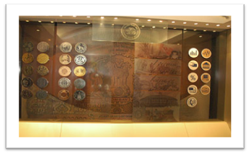 |
The Indian Institute of Research in Numismatic Studies Established in 1980 & located in the scenic surroundings of Anjneri Hill is one of its kinds in Asia. Extensive archive of Indian Currency, photographs, articles, line drawings, replicas & a well-documented researched history of Indian currency that existed in India down the Centuries makes Coin Museum a place worth to visit. The institute has also preserved One Lac cardexes for easy reference. It has become the global destination for tourist for study & research. The Institute undertakes workshops to promote coin collections in India. K.J.Maheshwari Art Gallery has national & international award winning rare photographs taken by Mr. K .J. Maheshwari. |
| 11. Teertharaj Gajapantha - Chamber Caves |
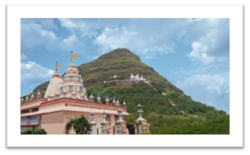 |
Nashik City and the surrounding area is famous for many temples, pilgrimage places etc. One of the sacred places for Jain Religion is Teerthraj Gajpantha , which is at Mhasrul, 16 kms from Nashik Road Railway station and 5 kms from Nashik City. The famous CHAMBER CAVES are a part of this place. It is situated on the top of a small hill which is only 400 ft tall. The staircase, built in black stone leads to the temple and offers a panoramic view. Although the nearby landscape is quite barren, some plantation has been recently done. This is a very serene place, conducive for meditation. Gajapantha Teerth includes a caravanserai, a small hut the foot of the hill |
|
and a temple at the top of the Gajadhwaja Hillock. As per the ancient holy book "Shantinath Purana" Mysore's Chamaraj King installed these statues (600 B.C.) in the temple top the hill. Thus the caves got the name "Chamer Caves" or "Chambhar Caves" in the regional language. |
| 12. Shree Sunder Narayan Temple |
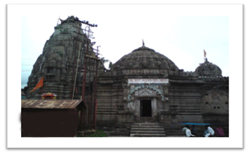 |
The Sundarnarayan temple is built by Gangadhar Yashwant Chandrachud in 1756 at a distance of 1 km from Central Bus Stand. The entrance of the temple is to the East. The architecture is attractive and the round dome is made by little ornamental cordons. The arched recesses are impressions of Mughal sculpture. The main deity is of Lord Vishnu - also called Narayana. To the left and right are Laxmi and Saraswati respectively. Fine design is carved on the stones of the temple. On the road leading towards Godavari River there is Badarika Sangam Pond. It is said that the king of Devgiri bathed and performed rites in this pond. One remarkable thing about this temple is that it is built at such an angle that on 21st March, rays of the rising Sun first fall exactly upon the idols. |
| 13.Mukti Dham |
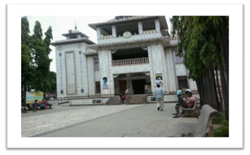 |
Muktidham temple is situated in Nashik Road. Built by Late Shri JayramBhai Bytco, is magnificent piece of architecture, made with marble from Makran in Rajasthan, and by Rajasthani sculptors. Unique to this temple are eighteen chapters of Geeta written on the walls. You can also see the replicas of all the twelve Jyotirlingas over here and also icons of all major Hindu Gods and Godesses. After visiting this temple one gets a feeling of visiting all the four Dhams in India. This temple is situated at a distance of 8 km from Central Bus Stand |
| 14.Bhakti Dham |
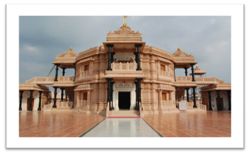 |
Bhakti Dham is sitiauted near Dindori Naka, at a distance of 2km from Central Bus Stand. This place is renowned for various temples built in the premises and all religious rituals, pujas and vidhis are carried out in Bhakti Dham. |
| 15. Shree Kapaleshwar Mahadev |
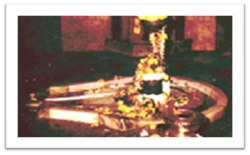 |
Situated at a distance of 1km from Central Bus Stand, this temple is one of the peculiar Mahadev Temples in Nashik.The most prominent aspect regarding this temple is there is no idol of Nandi in front of Lord Mahadev.Shravani Somvar (Monday) and Shivratri are the 2 days when pilgrims gather in large numbers in this temple. |
| 16. Shree Someshwar Temple, Gangapur |
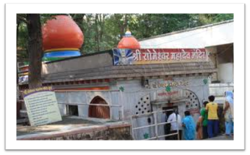 |
This temple is on the way to Gangapur dam, at a distance of 8km from Central Bus Stand. This is a temple of Lord Shiva and Lord Hanuman on the banks of river Godavari. The area is covered with greenery, with a pleasant climate. Tourists can take pleasure of swimming and boating in the river. Someshwar has been a favourite location for many a film shootings. On the way to Someshwar, there is a village named Anandwalli. It is so named because Peshwas - Anandibai and Raghobadada, lived there for some time. The temple - Navasha Ganpati was built by them |
| 17. Shree Ved Temple |
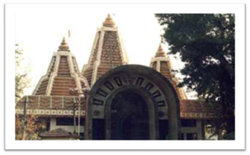 |
The Ved Temple, situated at a distance of 1.5km from Central Bus Stand, was built with the aim of studying Indian culture and Ved and Puranas. A private trust of Mr Sarada founded the temple. The temple is the example of modern interiors with Italian Marble. The entrance to the temple is very large and attractive with glasses and flood lights. Free training and education on Ved-Puranas is given to students from all over India. The temple has the idols of Shriram, Laxman and Sita. Along with them is the idol of Guru Gangeshwaranandj. |
| 18. Dutondya Maruti |
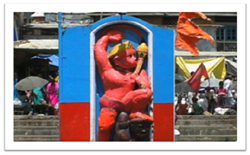 |
This idol of Lord Maruti is placed on the bank of Godavari river near Ramkund. This idol has two faces on either side. |
| 19. Saptashringi Devi Temple |
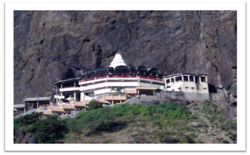 |
The temple of goddess Saptashringi resides 55 kms from Nashik at Wani. As you approach the temple a large rocky hill greets you. This is Saptashringi Hill. The goddess is known to have possessed 18 weapons in 18 hands and is positioned ready to fight the demons.
The journey to the temple also has some interesting sights to offer. On the way, you can stop at the Maharashtra Engineering Research Institute (MERI) or at Sitakund at Mhasrul village. This is the site where Sita the wife of Rama used to bathe. This destination is filled with stories and legends connected to the Ramayana.
Saptashringa Garh is a place where Goddess Bhagawati dwells.It is one of the |
|
most important of the places of Goddesses in Maharashtra. Saptashringa signifies seven mountain peaks. Nanduri village is situated at the foot of the Saptashringa Gad. In front of the temple there stands Markandeya Rishi's (sage) hill. The Saptashringa Gad is full of a variety of trees having medicinal worth. As per the story depicted in Ramayana, Hanuman carried the herbal medicine for wounded Laxmana from this hill. There are about 108 water reservoirs on the hill, known as Kundas.
Saptashringa Garh is a place where Goddess Bhagawati dwells.It is one of the most important of the places of Goddesses in Maharashtra. Saptashringa signifies seven mountain peaks. Nanduri village is situated at the foot of the Saptashringa Gad. In front of the temple there stands Markandeya Rishi's (sage) hill. The Saptashringa Gad is full of a variety of trees having medicinal worth. As per the story depicted in Ramayana, Hanuman carried the herbal medicine for wounded Laxmana from this hill. There are about 108 water reservoirs on the hill, known as Kundas.
|
| 20. Nandurmadhmeshwar |
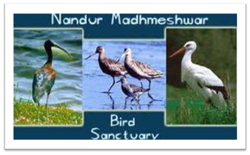 |
Nandurmadhmeshwar is at a distance of 60 km from Nashik. There is a bird sanctuary here. This place is known as bird-lover's paradise. This place is also known as the Maharashtra's Bharatpur. This bird sanctuary has been developed here since 1950. Nandurmadhmeshwar is home to thousands of migratory birds. October to March is the ideal season to bird watch. |
| 21. Bhandardara |
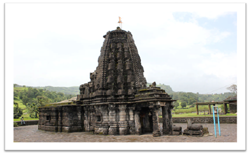 |
Bhandardara is located at a distance of 70 km from Nashik. It is a small and peaceful area. This hill station is popular for fun loving and picnic lovers. Radha Falls, a deep valley, a clean and large Arthur Lake, a historical Ratangadh Fort, an ancient temple - Amritheshwar Temple, a peaceful Agasti Rishi Ashram, Wilson Dam also known as Bhandardara Dam, and Viewpoints are the important destinations at Bhandarda. It also has a trekking destination - Mount Kalusubai. The largest earthen dam in the country and one of the oldest dams in Asia, Wilson Dam or Bhandardara Dam is at Bhandardara. The height of the dam is nearly 150 m. The overflowing water makes the Umbrella Falls, which is a picturesque sight during the monsoon season. |
| 22. Jawhar |
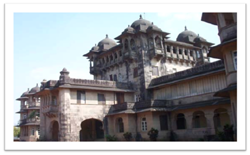 |
Jawhar hill station is in Thane district of Maharashtra. Gifted with exotic valleys, thick rich forests and pleasant climate, Jawhar offers different type of enjoyment comparing to other hill stations of Maharashtra. Jawhar is popular for its lively Warli paintings. This hill station is one of the few tribal kingdoms in Maharashtra. Tourists can visit Jai Vilas, the Palace of the tribal lords that offers a unique opportunity to expose and enlighten with the tribal way of life. Bhupatgad relics are also worth a visit. Nashik is at a distance of 80 km from here |
| 23. Shirdi |
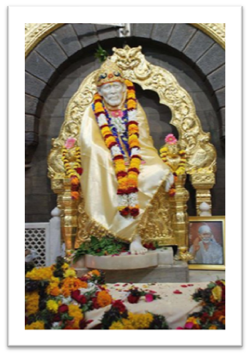 |
Shirdi, a small village in Kopargam Taluk, in Ahmadnagar, Maharashtra is regarded to be an important pilgrimage place in India as sage Sai Baba lived here till his death. Popularly known as the 'Child of God', Sai Baba preached tolerance towards all religions and the message of universal brotherhood.
After his death, Sai Baba's fame has spread far and wide.
Sai Baba believed and respected all religions. Samadhi Temple was started during the lifetime of Sai Baba, with a view to having a temple of Sri Krishna. But later, Sai Baba himself decided to live there. So, after Sai Baba attained Nirvana (eternal peace), His mortal remains were buried at the place. The articles and valuables, which were used by the Baba, are exhibited in a room here.
Every activity at Shirdi revolves around the vast temple complex dedicated to Sai Baba. Devotees start queuing up in the early hours of dawn to catch a glimpse and seek the blessings of the life-size statue of Sai Baba. Thursday is marked by special pujas and darshan of the Sai Baba statue.There are other places of interest that devotees can visit as well including Dwarkamani Mosque where the Baba meditated and slept on alternate nights. Near the mosque, in a corridor is the dhani or eternal flame that burns day and night. Other places of importance are the Gurusthan, the Kandoba Temple, Shani Mandir, Narsimha Mandir, Changdev Maharaj Samadhi and the Sakori Ashram. |
| 24. Dudhasagar Waterfalls |
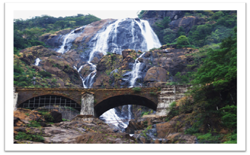 |
This is one of the more picturesque spots around Nashik. Cascading 10 m into the valley at Someshwar are the Dudhasagar Waterfalls. The spumes from the waterfall appear milky white and hence the name dudha or milk. You can reach the waterfall easily as there are steps cut into the rock. This spot is particularly beautiful just after the rains.
It is a favorite destination for youngsters where they come often to liven up their spirits. This is one of the best picturesque spots in Nashik.
|
| 25. Ajanta Caves |
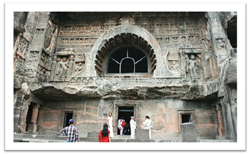 |
The Ajanta Caves are situated at a distance of 107 km north of Aurangabad. These caves were discovered by an Army Officer in the Madras Regiment of the British Army in 1819 during one of his hunting expeditions. Instantly the discovery became very famous and Ajanta attained a very important tourist destination in the world. Ajanta, a UNESCO world heritage site, is famous for its Buddhist rock-cut cave
temples and monasteries with their extraordinary wall paintings. These caves are excavated in horse–shoe shaped bend of rock surface nearly 76 m in height overlooking a narrow stream. This valley provides a calm and serene environment for the Buddhist monks who
|
|
retreated at these secluded places during the rainy seasons. This retreat also provided them with enough time for furthering their religious pursuits through intellectual discourses for a considerably longer period. The caves were excavated in different periods (circa. 2nd century B.C. to 6th century A.D.) according to the necessity. Each cave was connected to the stream by a flight of steps, which are now almost obliterated, albeit traces of some could be noticed at some places.
|
| 26. Ellora Caves |
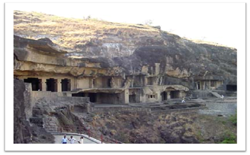 |
These 34 monasteries and temples, extending over more than 2 km, were dug side by side in the wall of a high basalt cliff. Ellora, with its uninterrupted sequence of monuments dating from A.D. 600 to 1000, brings the civilization of ancient India to life. Not only is the Ellora complex a unique artistic creation and a technological exploit but, with its
sanctuaries devoted to Buddhism, Hinduism and Jainism, it illustrates the spirit of tolerance that was characteristic of ancient India. The Ellora caves are located approx 25 km from Aurangabad. The approach road is good. One passes the Daulatabad fort on the way. There are 34 caves and a lot of walking to be done from cave to cave and within the caves so comfortable footwear is a must though one can also go by
|
|
car and see three to four caves at a time the caves one must see are 29,32 ,33,34 also 16 . 32 has the colored painting, a hall which echoes and pillars. on which one can knock on to get the sound of the tabla. Cave 29 is the water fall cave. From Aurangabad, one can visit along with Ghrushneshwar (Ellora) & bhadra maruti (Khuldabad) temples & famous Daulatabad (Devgiri) fort. Multiple travel choices are available.
|
| 27. Grishneshwar Jyotirlinga |
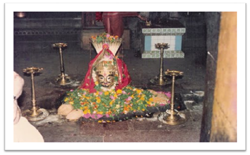 |
Grishneshwar Jyotirlinga is one of the 12 Jyotirlinga shrines mentioned in the Shiva Purana. Grishneshwar is believed as the Last or 12th (twelfth) Jyotirlinga on the earth. This pilgrimage site is located at a village called Verul which lies at a distance of 11 km from Daulatabad and 30 km from Aurangabad. It lies at a close proximity to the Ellora caves.
|
| 28. Bhadra Maruti Temple |
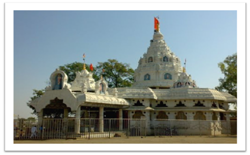 |
Bhadra Maruti Temple, Khuldabad is a famous temple dedicated to Hanuman located at Khuldabad, near Aurangabad, Maharashtra. The temple is just four kilometers from world famous Ellora caves.
The idol of Hanuman, here is in reclining or sleeping posture. It is one of the only three places where you will find Hanuman in a sleeping posture, second known place being at Allahabad, Uttar Pradesh and the third is at Jam Sawali, Madhya Pradesh.
The folk fare attached to this temple is that in ancient times the Khuldabad was known as Bhadravati. The ruler of the place was a noble king named Bhadrasena, who was an ardent devotee of Sri Rama and used to sing songs in His praise. One day Hanumanji descended in the place, listening to the devotional
|
|
songs sung in praise of Rama. He was mesmerized and without his knowledge took a reclining posture – called 'Bhava-samadhi'. King Bhadrasen, when finished his song, was astonished to find Hanuman in Samadhi before him. He requested Hanuman to reside here forever and bless his and Lord Rama's devotees.
|
| 29. Bhimashankar Jyotirlinga |
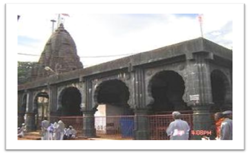 |
Bhimashankar Temple is a Jyotirlinga shrine located 50 km northwest of Khed, near Pune, in India. It is located 127 km from Pune in the Ghat region of the Sahyadri hills. Bhimashankar is also the source of the river Bhima, which flows southeast and merges with the Krishna River near Raichur.
The Bhimashankara temple is a composite of old and the new structures in the Nagara style of architecture.
It shows the Excellency of the skills achieved by ancient Vishwakarma sculptors. It is a modest yet graceful temple and it dates back to 13th century and the sabhamandap developed in 18th century by Nana Phadnavis. The shikhara was built by Nana Phadnavis. The great Maratha ruler Shivaji is said to have made endowments to this temple to
|
|
facilitate worship services. Although the structure here is fairly new, the shrine Bhimashankaram have been referred to in literature dating back to the 13th century CE. Saint Jñāneshwar is said to have visited Tryambakeshwar and Bhimashankar. A unique bell (Roman style) can be seen in front of the temple which was presented by Chimaji Appa (Brother of Bajirao Peshwa).
|
| 30. Daulatabad |
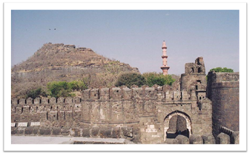 |
Daulatabad is a 14th-century fort city in Maharashtra, India, about 16 kilometers northwest of Aurangabad. The place, was once as known as Deogiri,
Starting 1327, it famously remained the capital of Turkic, Tughlaq dynasty, under Muhammad bin Tughluq (r. 1325-1351), who also changed its name, and forcibly moved the entire population of Delhi here,
for two years, before it was abandoned due to lack of water. There is a tradition that Deoghur or Doulatabad was built in 1203 AD by a Dhangar or herdsman who acquiring by some unusual good fortune vast wealth was named by his brother shepherds Rajah Ram and soon after assumed the rank of a Rajah. The area of the city includes the hill-fortress of Devagiri. It stands on a conical hill, about 200 meters
|
|
high. Much of the lower slopes of the hill have been cut away by Yadava dynasty rulers to leave 50 meter vertical sides to improve defenses. The fort is a place of extraordinary strength. The only means of access to the summit is by a narrow bridge, with passage for not more than two people abreast, and a long gallery, excavated in the rock, which has for the most part a very gradual upward slope. About midway along this gallery, the access gallery has steep stairs, the top of which is covered by a grating destined in time of war to form the hearth of a huge fire kept burning by the garrison above. At the summit, and at intervals on the slope, are specimens of massive old cannon facing out over the surrounding countryside. Also at the mid way, there is a cave entrance meant to confuse the enemies.
|